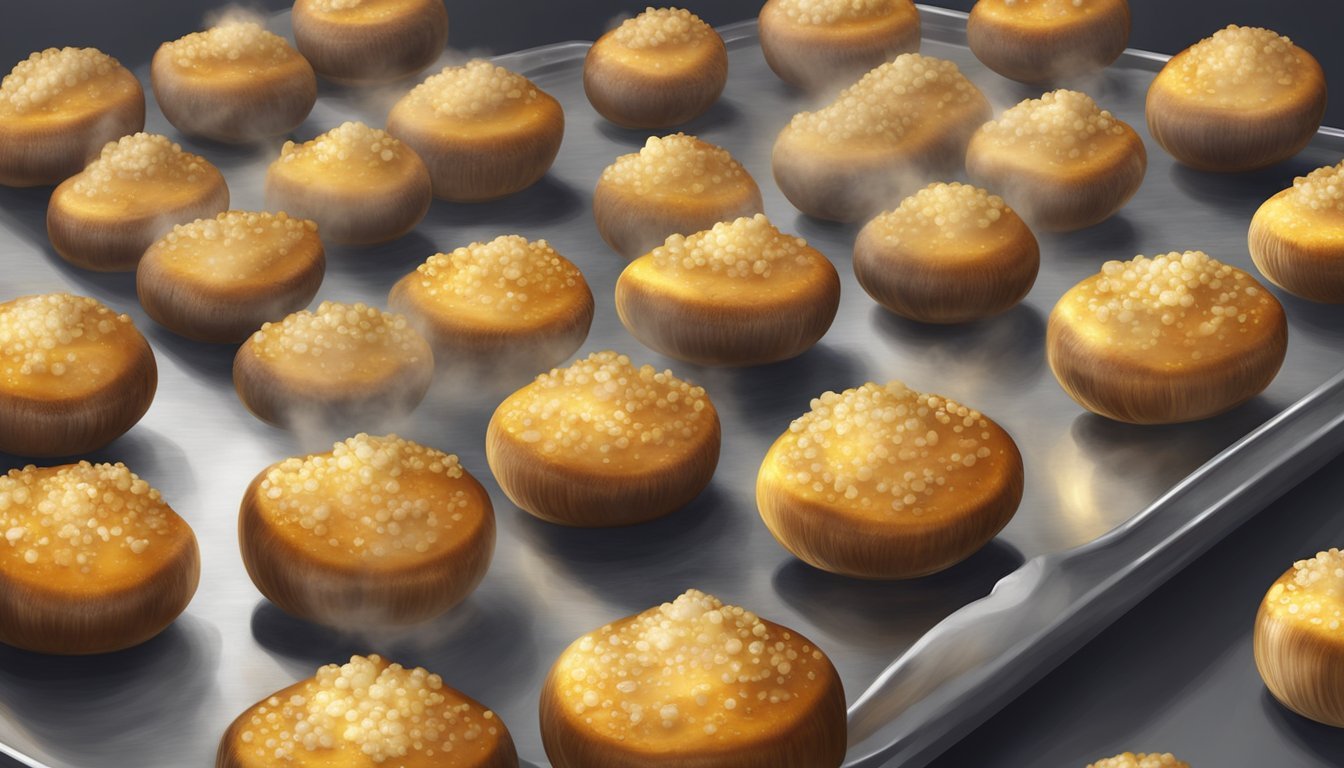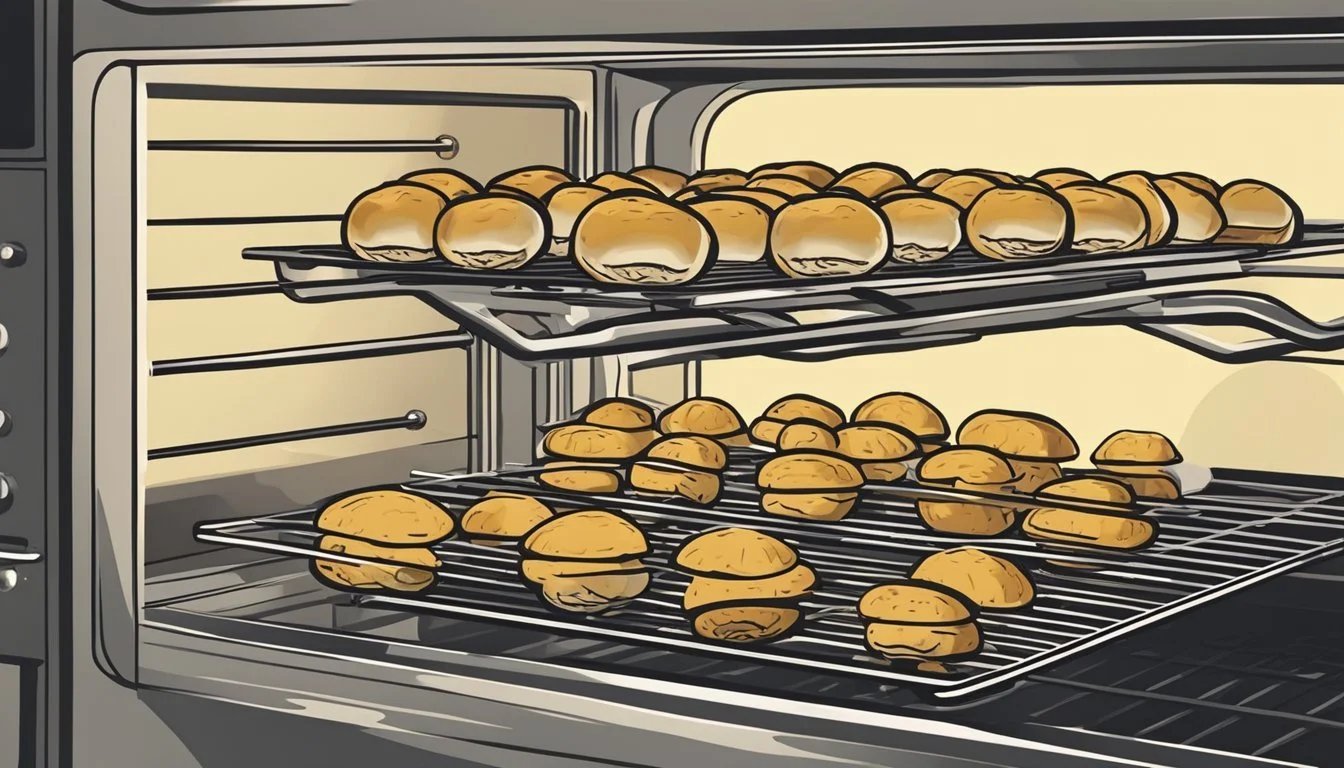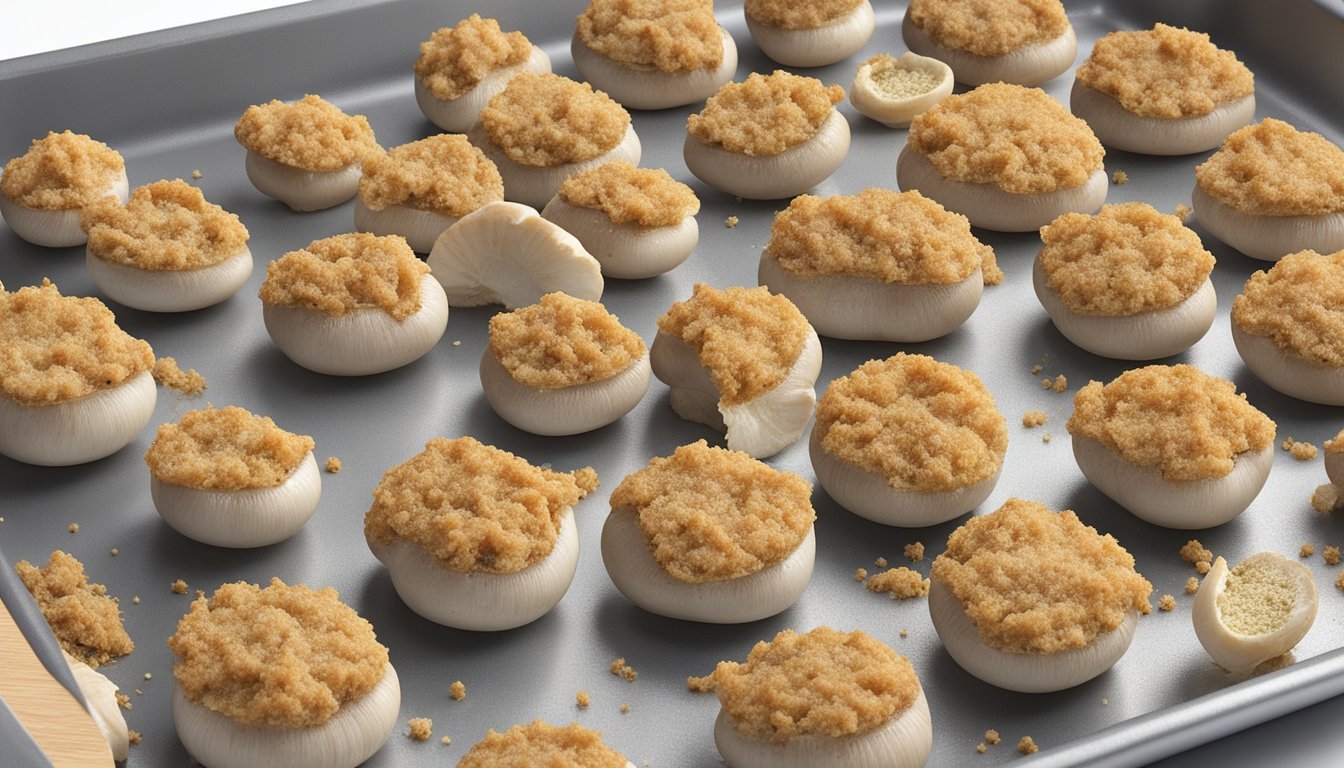Best Way to Reheat Stuffed Mushrooms
Ensuring a Crisp, Satisfying Bite Every Time
Stuffed mushrooms (What wine goes well with mushrooms?) are a beloved appetizer or snack, well-known for their flavorful and juicy fillings encased within tender mushroom caps. The art of reheating these delicacies lies in preserving the moisture of the mushrooms without turning them soggy, which can ruin their texture and diminish the overall taste experience. Achieving this begins with understanding the interaction of heat with the mushrooms' ingredients and their inherent moisture content.
Reheating techniques vary, but some methods stand out for consistently delivering firm, warm, and palatable stuffed mushrooms. The key is to gently warm them through, allowing the heat to penetrate without causing the mushrooms to release excessive water. The chosen method should enhance the flavors of the mushroom recipes and respect the integrity of the ingredients nestled inside each cap. Ensuring that stuffed mushrooms retain their structure and flavor when reheated is essential, whether enjoyed as a simple snack or as the highlight of a gourmet meal.
Understanding Stuffed Mushrooms
Stuffed mushrooms are a culinary delight that blend the savory flavors of their fillings with the distinct taste and texture of mushrooms. Preparing them optimally preserves their mouthfeel and taste.
Types of Mushrooms and Stuffing
White mushrooms: Common for stuffing, they have a mild flavor that pairs with various ingredients.
Baby bella mushrooms (Cremini): Offer a deeper, earthier flavor compared to white mushrooms.
Portobello mushrooms: Large and robust, they are ideal for heartier fillings.
Stuffings often include a combination of:
Cheese: Cream cheese (how long does cream cheese last?), mozzarella, and parmesan cheese are popular options for a creamy texture.
Meats: Bacon or sausage may be added for a savory depth of flavor.
Vegetables: Spinach, artichokes, (What wine goes well with artichokes?) and garlic are frequently featured for their nutritional value and taste.
Herbs and Seasonings: Chives, salt, and other spices add complexity.
Breadcrumbs: Often used to add a crunchy texture to the topping of the mushrooms.
Nutritional Benefits
Stuffed mushrooms can provide:
Fiber: Essential for digestive health.
Protein: Especially when incorporating meat or cheese.
Vitamins and Minerals: Mushrooms are a source of B vitamins, potassium, and selenium.
The stuffing ingredients can enhance these benefits but can also add to the calorie and fat content, depending on the use of cheese, cream, and meat.
Popular Stuffed Mushroom Recipes
Recipes may vary, but some popular ones include:
Spinach and Artichoke: Spinach and artichokes mixed with cream cheese and garlic.
Bacon and Cheddar: A mixture of crispy bacon, cheddar, and breadcrumbs.
Mediterranean Style: Incorporating olives, feta cheese, and sun-dried tomatoes.
Cooking methods like the oven are typically used to heat the filled mushrooms evenly. Ingredients such as olive oil or butter are commonly used to prevent sticking and enhance flavor when reheating.
Pre-Reheating Preparation
Proper pre-reheating preparation is crucial to achieve the best texture and flavor when reheating stuffed mushrooms. This involves temperature adjustment and moisture control techniques that can significantly improve the final outcome of the reheated mushrooms.
Bringing Stuffed Mushrooms to Room Temperature
Before reheating, it's beneficial to bring stuffed mushrooms to room temperature. This allows for more even reheating and reduces the risk of thermal shock, which can adversely affect their texture. They should sit out of the refrigerator for about 20 to 30 minutes to gently come up to room temperature.
Preventing Moisture Buildup
To prevent sogginess and ensure stuffed mushrooms maintain their pleasing texture, one must manage their moisture content effectively.
Water: If any water has accumulated around the mushrooms, it should be carefully drained.
Paper Towel: Patting the mushrooms dry with a paper towel can help absorb excess moisture before reheating them.
Melted Butter: A light brushing of melted butter can create a subtle barrier that prevents moisture from making the mushrooms soggy.
Aluminum Foil: When using an oven to reheat, covering the stuffed mushrooms with aluminum foil can help retain moisture without trapping excessive steam. This method allows for gentle reheating and helps distribute the heat evenly.
Reheating Techniques
Selecting the appropriate reheating method is crucial to maintain the texture and moisture of stuffed mushrooms. Below, various techniques are detailed that ensure even heating and prevent sogginess.
Using the Oven
For oven reheating, preheat to 350°F and arrange the mushrooms on a baking sheet lined with parchment paper. Cover the mushrooms with aluminum foil to lock in moisture and bake for 10-15 minutes. This method distributes heat evenly, maintaining the structure of the mushrooms.
Microwave Best Practices
To microwave, place mushrooms in a microwave-safe dish and cover with a damp paper towel. Heat on high power for 20-30 seconds intervals, checking frequently. Microwaving is quick but can unevenly heat the mushrooms, so proceed with caution to avoid rubbery textures.
Stovetop Reheating Method
On the stovetop, add a tablespoon of olive oil to a skillet over low heat. Place mushrooms in the pan, cover with a lid, and cook for 5-7 minutes, occasionally adding a small amount of water to generate steam. This helps reheat the mushrooms gently.
Utilizing Air Fryer for Crispness
The air fryer should be set to 350°F. Place mushrooms in the air fryer basket in a single layer, ensuring they are not overcrowded. Heat for 3-5 minutes. This method circulates hot air around the mushrooms, giving them a crisp exterior.
Toaster Oven Reheating
Reheat in a toaster oven preheated to 350°F by placing mushrooms on a baking sheet or aluminum foil. Heat for 5-10 minutes. The toaster oven is a suitable alternative to a regular oven, providing similar results on a smaller scale.
Slow Cooker Warming
For gradual reheating, set the slow cooker to low heat. Add mushrooms to the ceramic dish, cover, and allow them to warm up for about 30 minutes to 1 hour. This method is less likely to dry out the mushrooms but takes longer than other methods.
Preventing Sogginess
When reheating stuffed mushrooms, ensuring that they retain their texture and avoid becoming soggy is paramount. The right reheating technique keeps the mushrooms' integrity intact.
Importance of Dry Heat
Selecting an appropriate reheating method that provides dry heat is essential to avoid soggy mushrooms. The oven and stovetop methods are typically best for this purpose. When using an oven:
Temperature: Preheat the oven to 350°F (175°C).
Placement: Position mushrooms on a baking sheet lined with parchment paper.
Duration: Heat them for 10-15 minutes, depending on size.
For stovetop reheating:
Setup: Use a skillet over low heat.
Oil: Add a tablespoon of olive oil to prevent sticking.
Lid: Cover with a lid to trap heat without creating moisture.
Covering Techniques
Proper covering methods contribute greatly to preventing moisture buildup which leads to sogginess. When using the oven:
Aluminum Foil: Cover mushrooms loosely with aluminum foil to protect them while allowing air circulation.
In contrast, when mushrooms are notably moist:
Uncovered: It is sometimes better to leave them uncovered in the oven to allow excess moisture to evaporate.
Utilizing Absorbent Materials
Incorporation of absorbent materials can assist in moisture control. Here is how you can use such materials:
Baking Sheet Preparation: Before placing mushrooms on a baking sheet, one could lightly grease the sheet with olive oil or butter. This not only prevents sticking but can also help in gently crisping the mushrooms.
Parchment Paper: Lining a baking sheet with parchment paper is recommended to absorb excess grease and moisture.
Through the application of these strategies, reheated stuffed mushrooms will maintain their desirable texture.
Storing Leftovers for Optimal Freshness
Proper storage is crucial to keep stuffed mushroom leftovers fresh and prevent them from becoming soggy. Utilize freezing, refrigeration, and effective wrapping techniques to maintain the quality and texture of the mushrooms until reheating.
Freezing Stuffed Mushrooms
For long-term storage, it's recommended to freeze stuffed mushrooms. Place the mushrooms on a baking sheet and freeze them individually before transferring to an airtight container or freezer bag to prevent them from sticking together. This step ensures freshness and texture are preserved for up to three months.
Refrigeration Best Practices
Refrigerate stuffed mushrooms within two hours of cooking to minimize the risk of bacterial growth. Use shallow airtight containers to store them, which helps to retain moisture without making the mushrooms soggy. Stuffed mushrooms properly stored in the refrigerator will stay fresh for three to five days.
Containers and Wrapping Techniques
The choice of container and wrapping impacts how well the mushrooms hold up. Plastic wrap can be used directly on the mushrooms before placing them in a container to minimize air exposure. Alternatively, one can opt for storage in airtight containers, which protect against moisture and external odors. Avoid using aluminum foil, as it might not provide the necessary barrier to moisture and odors if not wrapped tightly.
Serving and Pairing Suggestions
Once the stuffed mushrooms are perfectly reheated, pairing them with the right side dishes and beverages can enhance the dining experience. Here are some suggestions that complement their earthy flavor and consider their role as a nutrient-rich appetizer, often high in vitamin D and potassium.
Complementary Side Dishes
Salads: A simple arugula salad with a lemon vinaigrette can balance the richness of the stuffed mushrooms.
Breads: Offer slices of crusty baguette to complement the mushrooms' texture.
Wine and Beverage Pairings
White Wines: Choose a Chardonnay or Sauvignon Blanc for their ability to accompany the mushrooms' savory notes.
Non-alcoholic: Sparkling water with a twist of lemon serves as a refreshing palate cleanser.
Occasions and Events
For casual gatherings or elegant parties, stuffed mushrooms serve as a versatile appetizer. They pair well with a variety of dishes and drinks, making them suitable for:
Cocktail Parties: As a finger food that's easy to consume while mingling.
Sit-down Dinners: Serve as a side dish before the main course, enhancing the meal’s complexity.
Food Safety Considerations
When reheating stuffed mushrooms, it is essential to reach safe internal temperatures, minimize cross-contamination risks, and identify mushrooms that should not be consumed due to spoilage.
Reheating to Safe Temperatures
To ensure food safety, stuffed mushrooms should be reheated to an internal temperature of at least 165°F (74°C). The chosen cooking method, whether it's an oven or stove top, must be able to uniformly reheat the mushrooms without leaving cold spots.
Oven: Preheat to 350°F and reheat for 10-15 minutes.
Stove top: Use a skillet over low heat and cook for 5-7 minutes.
Avoiding Cross Contamination
One must be vigilant about cross-contamination when handling stuffed mushrooms both before and during the reheating process.
Use separate utensils and cutting boards for mushrooms and other foods.
Ensure all surfaces and tools are thoroughly cleaned before use.
Recognizing Spoiled Mushrooms
An individual should be able to spot spoiled mushrooms to avoid foodborne illness. Spoiled mushrooms typically have:
An off odor – a pungent, unpleasant smell.
Slimy texture – mushrooms should not be slippery or sticky to the touch.
Discoloration – look for brown spots or areas of darkening.
Discarding any questionable mushrooms is crucial for food safety.
FAQs on Reheating Stuffed Mushrooms
When reheating stuffed mushrooms, keeping them from becoming soggy is essential. This section offers practical advice and addresses common issues to ensure the mushrooms remain flavorful and retain their texture.
Common Concerns Addressed
How to prevent sogginess: The key is to heat the mushrooms evenly and gently. In the oven, one can preheat to 350°F and arrange the mushrooms on a baking sheet lined with parchment paper, reheating for about 10-15 minutes. A pro tip is to cover them with aluminum foil to retain moisture without becoming soggy.
Maintaining flavor: To sustain the mushrooms' savory taste, a light coating of oil or butter can help enhance their natural flavors during the reheating process.
Tips for Greater Convenience
Oven-batch reheating: When working with batches, make sure to space the mushrooms evenly on the baking sheet and avoid overlapping to ensure uniform warmth.
Stovetop reheating: This method allows for quick reheating in batches. Use a skillet over low heat with olive oil, reheating mushrooms with the lid on for 5-7 minutes. One can add a few tablespoons of water to create steam that gently warms them.
Troubleshooting Reheating Problems
Problem Solution Mushrooms are too dry. Cover with aluminum foil when reheating in the oven to trap moisture. Mushrooms got soggy. Ensure they're not overlapping during reheating and add less water if using the stovetop method.
By following these suggestions, one can reheat their stuffed mushrooms in the oven or on the stovetop, enjoying them as if they were freshly made.








